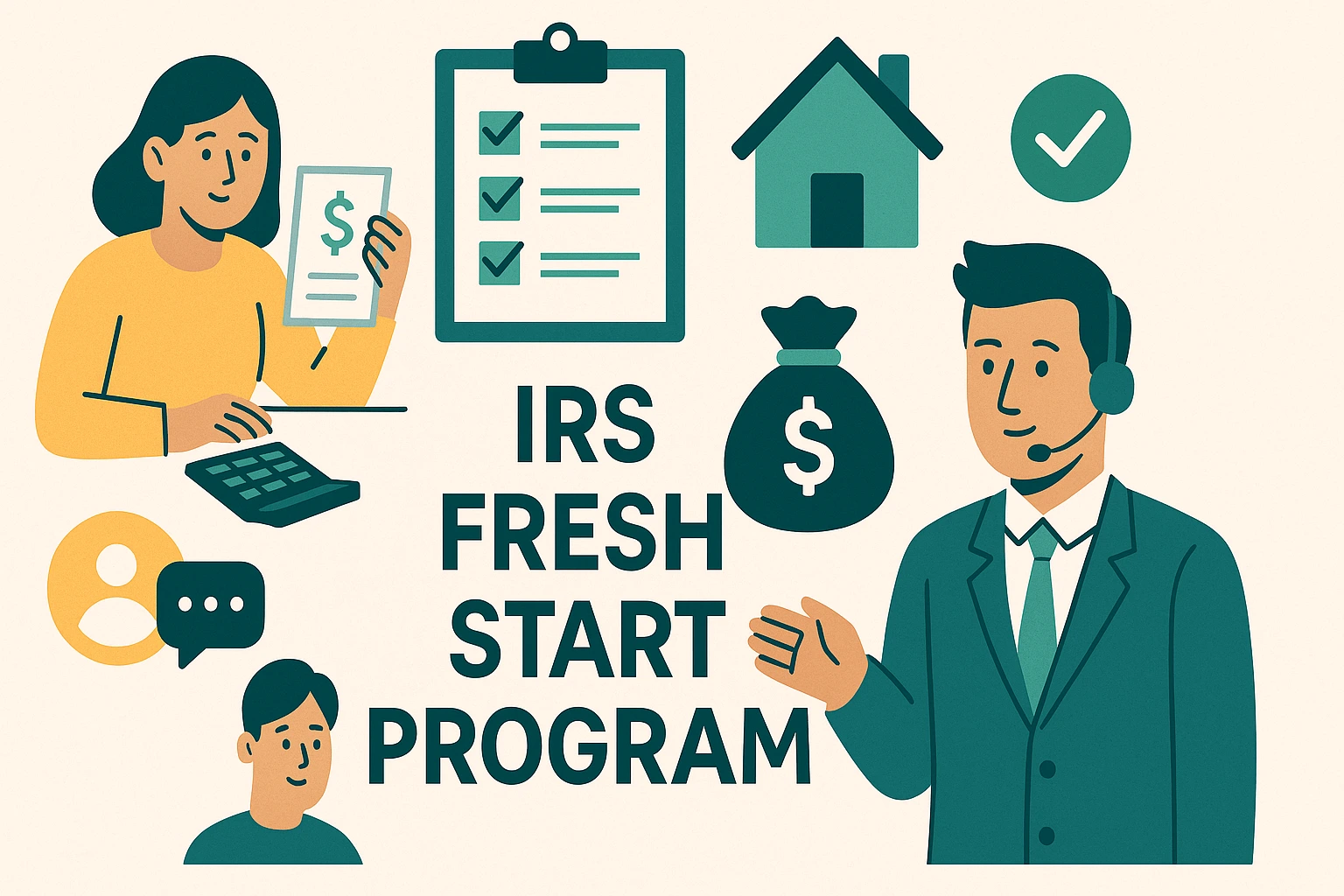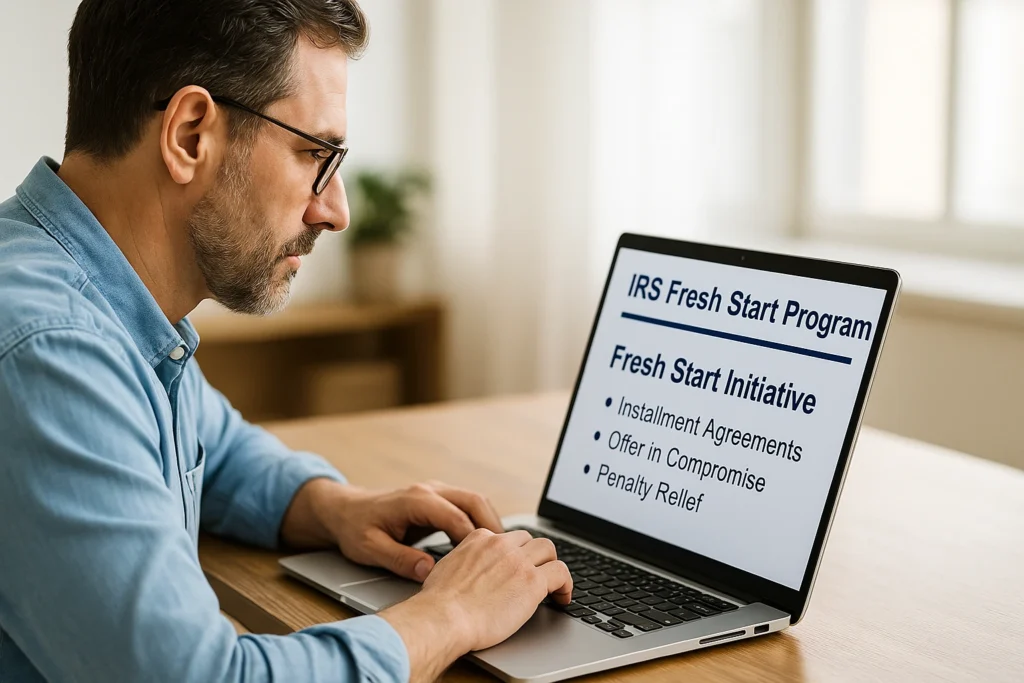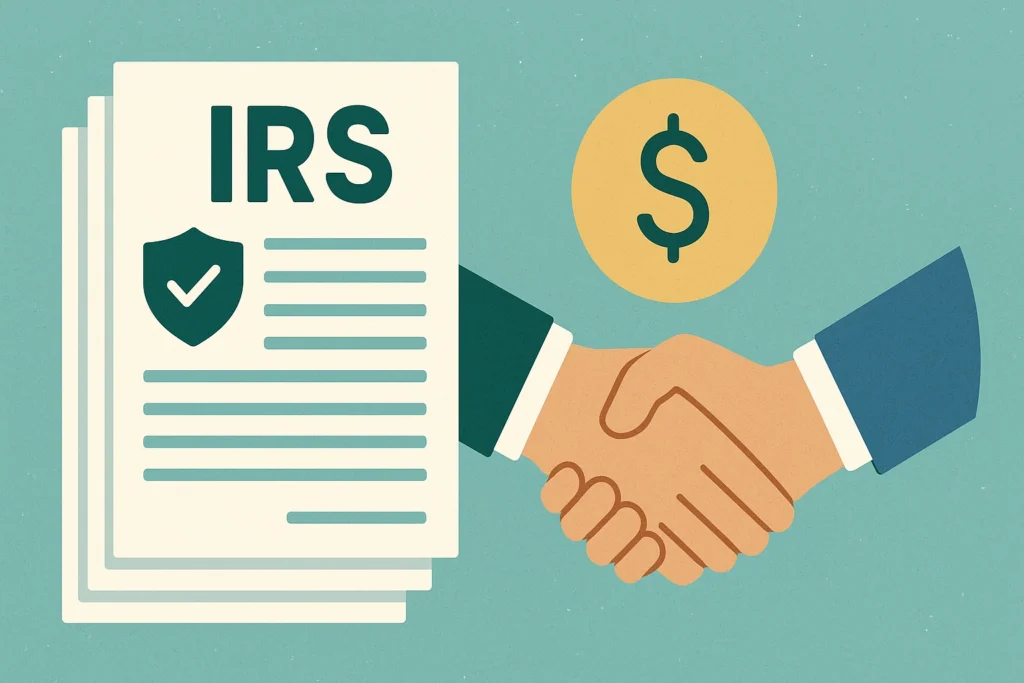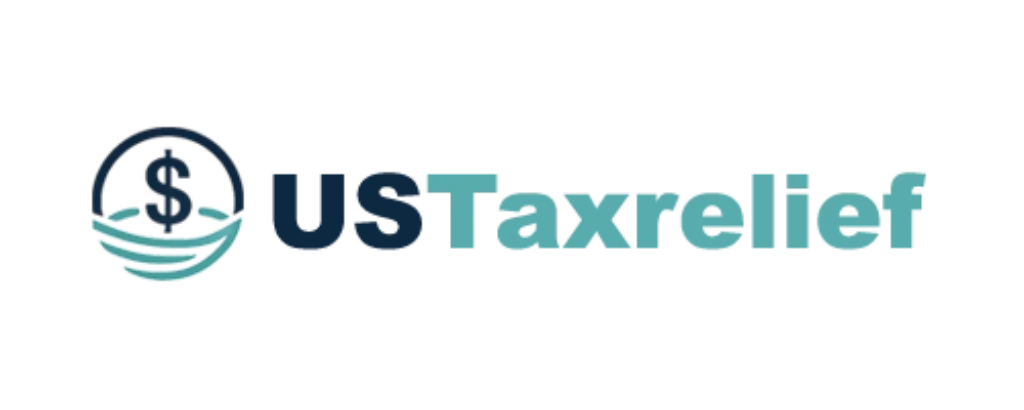
🎯 What Is the IRS Fresh Start Program?
If you’re struggling with tax debt, the IRS Fresh Start Program might be your path to relief.
Launched in 2011 and expanded in recent years, the Fresh Start Initiative is an IRS effort to make it easier for individuals and small businesses to pay back taxes without drowning in penalties or fear of aggressive collections.
But here’s the truth:
It’s not a magic “debt forgiveness” plan. It’s a set of expanded relief options that make it more manageable for everyday taxpayers to settle what they owe.
📦 It Includes Programs Like:
-
✅ Installment Agreements – pay what you owe in smaller monthly payments.
-
✅ Offer in Compromise (OIC) – settle your debt for less than you owe (if you qualify).
-
✅ Penalty Abatement – reduce or eliminate IRS penalties for first-time issues or reasonable cause.
These aren’t new programs—but under the Fresh Start umbrella, they’re more accessible than ever if you meet the right criteria.
💡 Want help applying?
👉 Compare top tax relief companies that can walk you through it »
🧾 Who Qualifies for the Fresh Start Program?
The good news? You don’t need perfect financials to qualify.
The IRS built this initiative for people just like you—those who’ve fallen behind, want to make it right, and need a more realistic path to do it.
Here’s what typically makes someone eligible:
✅ Basic Eligibility Requirements
-
You owe less than $50,000 in IRS tax debt (some exceptions apply).
-
You’ve filed all required tax returns (even if you can’t pay right now).
-
You’re not in active bankruptcy or dealing with serious fraud investigations.
-
You have a steady income or ability to repay over time.
-
You’re willing to set up a payment plan or submit an OIC.
⚠️ Important:
Even if you owe more than $50,000, you may still qualify with financial documentation or by making a down payment. Many tax relief firms can help with this paperwork.
🛠️ What Does the Fresh Start Program Include?
The Fresh Start Program isn’t a single form or shortcut—it’s a framework of IRS relief options that work together.
Here’s a breakdown of what’s included and how each piece works:
📆 1. Installment Agreements (IA)
Set up a monthly payment plan to gradually pay your debt.
-
Available if you owe under $50,000 and can pay within 72 months.
-
Requires minimal financial disclosure in many cases.
-
You can apply online via the IRS Online Payment Agreement Tool.
💸 2. Offer in Compromise (OIC)
If paying your full tax debt would cause financial hardship, you might qualify to settle for less.
-
Must prove you can’t afford the full amount based on IRS formulas.
-
You’ll need to submit IRS Form 656 and Form 433-A (OIC).
-
Acceptance is tough—but possible with the right financials and expert help.
🧾 3. Penalty Relief / Abatement
Fresh Start expanded access to first-time penalty abatement.
-
Often available for first-time late filers or those with a clean compliance history.
-
Can waive failure-to-pay and failure-to-file penalties, which often make up a big chunk of your total balance.

✅ Step-by-Step Guide to Apply
1. File All Your Tax Returns
Before the IRS will consider any relief, you must be fully compliant—which means all your past tax returns must be filed.
📌 Tip: Even if you can’t pay yet, file anyway. It avoids failure-to-file penalties and keeps the door open for relief.
2. Check Your Tax Debt Amount
Log into your IRS account or request a tax transcript to confirm how much you owe.
-
If you owe under $50,000, you may qualify for streamlined options.
-
For higher balances, additional documentation is required—but relief is still possible.
3. Choose Your Relief Option
Depending on your financial situation, you can apply for:
-
Installment Agreement (monthly payments)
-
Offer in Compromise (settle for less)
-
Penalty Abatement (reduce IRS penalties)
Each option has its own forms and process. See the table below:
| Relief Option | IRS Forms Needed | Apply Online? |
| Installment Agreement | None (if under $50k) | ✅ Yes |
| Offer in Compromise | Form 656, Form 433-A (OIC) | ❌ No |
| Penalty Abatement | Written request or Form 843 | ❌ No |
4. Submit Your Application
-
Online for payment plans under $50k → IRS Payment Tool
-
By mail for OIC or penalty relief → Include all forms, documents, and fees
💡 Want professional help applying?
👉 Compare top tax relief services that handle the full process for you »
⚖️ Pros and Cons of the IRS Fresh Start Program
Like any government program, Fresh Start has both benefits and limitations. Here’s what you need to know before applying:
✅ Pros
-
Stops IRS collections like wage garnishments or liens (once accepted)
-
Offers a realistic path to settle or pay down debt
-
Easier to qualify than older IRS policies
-
Reduces penalties that can double your balance
❌ Cons
-
Not everyone qualifies—OIC acceptance rate is low without help
-
You must stay 100% compliant after approval
-
Takes time—weeks or months, depending on the option
-
Financial documentation can be confusing or overwhelming
🎯 Bottom line: Fresh Start can be a lifeline, but it’s not automatic.
For the best outcome, consider getting expert help with the forms, strategy, and negotiations.

🧑💼 How a Tax Relief Company Can Help You Apply
While the IRS provides self-service tools, many taxpayers find the Fresh Start application process confusing, frustrating, or downright intimidating.
That’s where professional help comes in.
🛡️ Here’s What a Tax Relief Firm Can Do:
-
Assess your eligibility for all Fresh Start programs
-
Handle all paperwork and forms (OIC, IA, penalty relief)
-
Negotiate directly with the IRS on your behalf
-
Protect you from wage garnishments or bank levies while you apply
-
Represent you if your application gets rejected or audited
🤝 Most firms offer a free consultation so you can find out if they’re a good fit—before you commit.
🔍 When Should You Get Professional Help?
-
You owe more than $10,000 or have multiple years of unfiled returns
-
You’ve been denied relief in the past
-
You’re facing collections, liens, or levies
-
You’re self-employed or can’t easily prove hardship
✅ Want a hand with the IRS?
👉 Compare the top-rated tax relief companies now »
❌ Common Myths About the Fresh Start Program
There’s a lot of bad information out there. Let’s set the record straight.
⚠️ Myth #1: The IRS Will Erase All Your Debt
Not true. The Fresh Start Program helps reduce or restructure what you owe—but full forgiveness is rare and only possible through an approved Offer in Compromise.
⚠️ Myth #2: Anyone Can Qualify
The IRS looks closely at your income, expenses, assets, and history. If you can afford to pay, even slowly, you likely won’t qualify for a reduced settlement.
⚠️ Myth #3: It’s a One-Time Fix
Even after getting relief, you must stay fully compliant going forward. One missed payment or late filing can cancel your agreement.
💬 Tip: A qualified tax pro can help you avoid costly mistakes and improve your chances of success.
🏁 Conclusion: Is the Fresh Start Program Right for You?
If you’re feeling overwhelmed by tax debt, the IRS Fresh Start Program offers a clear path forward—but only if you take action.
Whether you choose to go it alone or work with a reputable tax relief service, the key is not waiting. Penalties and interest stack up fast—and IRS collection efforts don’t stop on their own.
👉 Take the First Step Today:
🔹 Check if you qualify
🔹 Choose the right relief option
🔹 Get expert help if needed
🚀 Ready to take control of your tax debt?
👉 Compare the best tax relief companies and apply faster »
❓ Frequently Asked Questions
What is the IRS Fresh Start Program?
A set of IRS policies designed to help struggling taxpayers pay back taxes more affordably through payment plans, settlements, and penalty relief.
Is the Fresh Start Program legit?
Yes—it’s a real IRS initiative launched in 2011 and expanded over time. However, not everyone qualifies automatically.
How do I apply for the Fresh Start Program?
You can apply directly through the IRS if you meet basic eligibility requirements. For complex cases, tax relief firms can assist.
Can I settle my tax debt for less?
Possibly, through an Offer in Compromise. But the IRS will require proof of financial hardship and thorough documentation.
Does the Fresh Start Program affect my credit?
The IRS does not report tax debt to credit bureaus. However, tax liens (if filed) may still appear on your public record and affect financial decisions.







